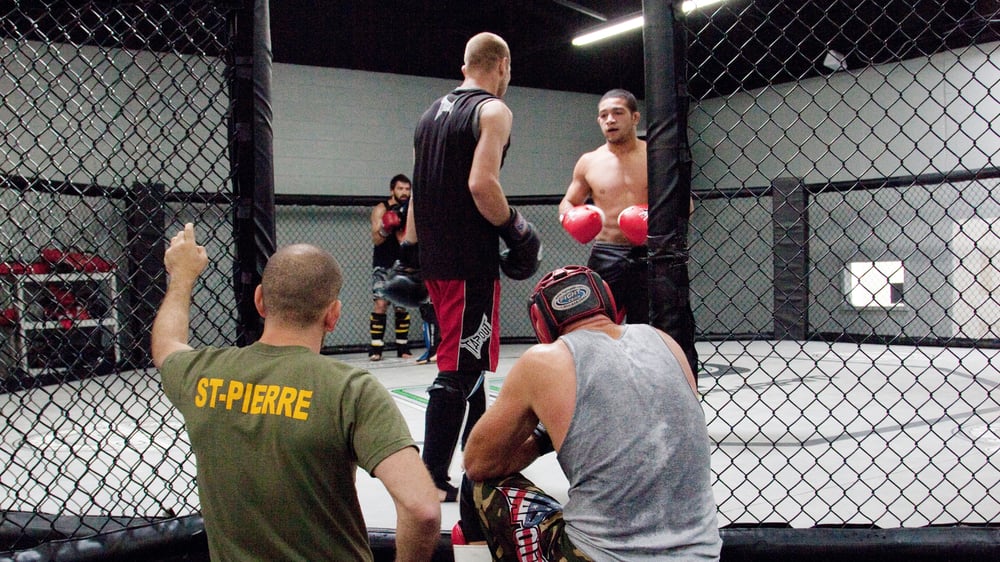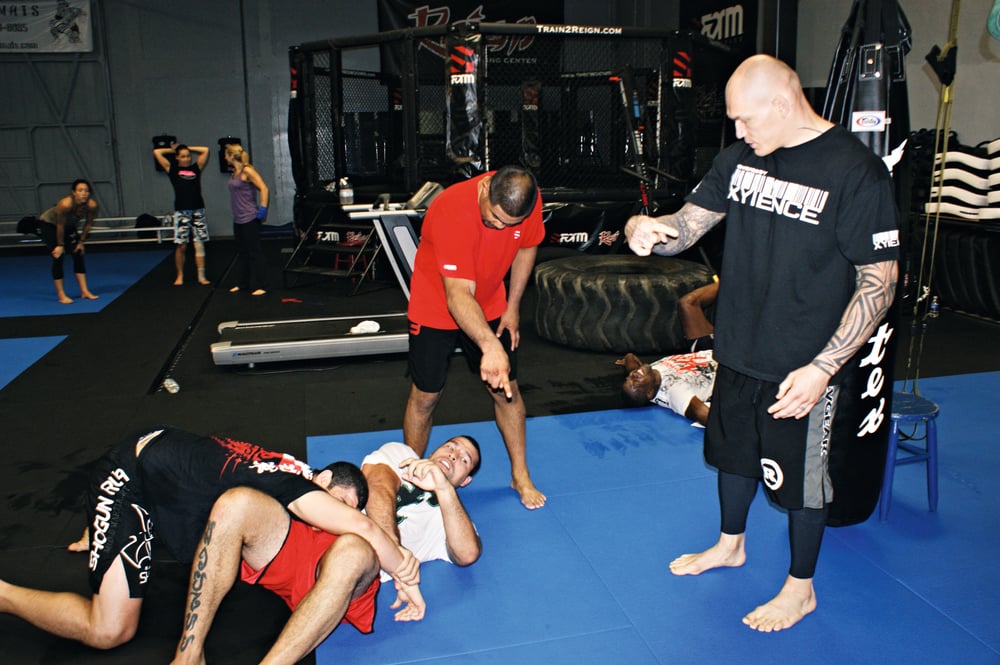
Issue 085
February 2012
How to choose the right gym to propel yourself toward Octagon gold
The average person requires at least 10,000 hours devoted to an activity before they master it. Time must equate to efficiency, and in the combat sports world, no wasted motion is the surest path to victory. No decision determines a fighter’s fate more than selecting a gym to call home – a home worth investing 10,000 hours of sweat equity in.
Gyms are intimidating structures. They are palaces of grime worn with the blood, sweat and tears – mostly blood – of the rags-to-riches hopefuls. They are sterile, cold and running on techno and top-40 songs meant to attract housewives and weekend warriors. And then there are the gyms mentioned consistently on UFC broadcasts: world-class fight facilities. But, with more martial arts schools than 7/11 convenience stores, how does one know where to dedicate their time?
STARTER’S ORDERS
Bob Cook, American Kickboxing Academy trainer and Zinkin Entertainment CEO, highlights the bottom line is that any first gym will teach something. But whether you’re stepping onto the mat or into the ring for the first time, competing on the amateur circuit or at the championship level, he says progress into becoming a better fighter depends on how the facility and fighter mesh in terms of attitude and fortitude. Skills build based on that foundation – making it just as important, if not more important, than talent.
UFC light heavyweight champion Jon Jones agrees. “I would say the most important things to consider are your potential relationships with the other fighters training at that gym and the coaches,” says Jones. “They become a second family to you. Fighters at gyms really support one another in all ways possible, and if that chemistry isn’t there or doesn’t begin to develop after your first few times at that gym, it’s probably not the best fit for that individual.”
You might already be able to smell that UFC championship but if you’re a beginner you’re best off starting slow. The manager at Gilbert Melendez’s El Nino Trainer Center, Eduardo Vargas, comments instructing a fighter is like teaching a baby to walk until it’s grown and ready to beat others up. “We want you to learn the right way – know how to do jiu-jitsu or Muay Thai – because, at the end of the day, you just become a better training partner.”
Gym offerings to look for in signing up are strong beginners programs that establish fundamentals without throwing you to the wolves too soon. Here, you’ll be able to hone your defenses before facing the facilities predators. Even if you own a stellar kickboxing resume, for example, leaping into pro MMA practices without learning any ground work will see your weaknesses constantly exploited.

FAILURE TO LAUNCH?
Before you agree to your first fight, Cook recommends testing whether or not combat is really the right endeavor by testing your skills outside of the gym in grappling competitions and striking smokers. Full-fledged fighting isn’t something to just jump into. “It’s a good start to get a taste,” says the UFC 24 veteran. Gym sessions simulate the live-fight experience. Competitions will stimulate the fight-or-flight performance nerves necessary for a pro fight career. Then a real mixed-fight career can begin.
Cook asserts the best way for a fighter to progress is to call a gym that turns deficiencies into strengths home. They should be able to meet all a fighter’s needs otherwise a fighter must align with extra networks – or find a new gym entirely – to bolster camps. Patience truly is a virtue: a fight career is a marathon, not a race – at least until fight time.
FIGHTING FIT
UFC light heavyweight Krzysztof Soszynski, a former bodybuilder and pro wrestler, believes starting his MMA career is the hardest thing he’s ever done. “When you’re 25 years old and you have no background in anything whatsoever, any type of martial arts at all, next thing you know you’re doing armbars and kimuras, you’re hooked doing this jiu-jitsu thing you’ve never heard of or seen before. Six months later you’re in a fight. It’s a rollercoaster ride. It still is a rollercoaster ride.”
For each piece of the physical puzzle, there’s a mental counterpart. Repetition drills are not just for fundamentals; they are for focus, mental endurance and humility. Vargas outlines MMA as a game with equal chance of winning and losing. So MMA’s greatest expectation extends beyond the 50:50 chance of landing in the win column. It’s a blend of the physical tangible (maximum effort in preparation), and the mental intangibles (heart and the refusal to quit).
Soszynski shares that his negative thinking garnered negative results until late coach Shawn Tompkins and former UFC heavyweight champion Bas Rutten turned him onto the tide of positivity. It proves that having coaches who understand the psychological game might mean the difference between a career as an also-ran and a lifetime as a legend.
Jones reveals the mental framework necessary for victory can unravel, even in fight camp at the last minute, if not threaded together by a positive outlook.
“A central focus and a self-awareness are key. If you are training right, working hard every day, there isn’t much to establish in those last days,” says the Greg Jackson-trained fighter rooted in Albuquerque, New Mexico. “It’s a slow progression over weeks and months that gets you into the right mental and physical state to compete at a high level.”

ONWARD AND UPWARD
Moving forward in your career might necessitate moving gyms. Soszynski departed Team Quest on good terms in order to train at Reign Training Center, both California based. It was by chance he met the owner, UFC middleweight Mark Munoz, running next to him on the treadmill one day. After accepting an invite to train and arriving in Lake Forest, California, Munoz and his wife greeted ‘The Polish Experiment’ with literal open arms.
The Ultimate Fighter season eight alumnus knew it was the right fit for him immediately. Sometimes you don’t choose the gym. Sometimes it chooses you.
The 34-year-old eight-year veteran has implemented his ‘K-Sos’ training system at Reign since anchoring himself there. It is an all-encompassing strength, conditioning and nutrition package specific to MMA. As such, the move has been personally and professionally positive. The blank intimidated student eventually becomes an animated teacher, fueling the cycle of intermediates, professionals and champions that comprise
the sport.
Mixed martial arts on TV appears to be an individual one-on-one endeavor, yet the symbiotic teacher-student relationship is integral to success. Choosing the right gym in which to put in your hours, at any stage of your career, is a personal one but nonetheless vital. After all, MMA training is a puzzle of at least 10,000 pieces begging to be solved.
THE KEYS TO VICTORY
BEGINNERS SHOULD:
Be personable and willing to learn
Have regular attendance and reliability
Have a motivated work ethic
THE KEYS TO VICTORY
UP AND COMERS SHOULD:
Be positive in learning all facets: striking, clinching and grappling
Engage in gym sparring assessments and live competition
Work through amateur, regional professional, national independents
and international fights
THE KEYS TO VICTORY
CHAMPIONS SHOULD:
Utilize diet, strength, conditioning, fight-specific technique drills and regular sparring partners as part of a camp
Have mental endurance
Perfect the camp.process and repeat










